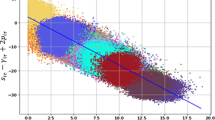Abstract
The main goal of the analysis is the verification of whether asynchrony in transaction times is a considerable cause of the Epps effect on the Warsaw Stock Exchange among the most liquid assets. A method for compensating for the impact of asynchrony in trading on the Epps effect is presented. The method is easily applicable. Calculations are made using the exact time of transactions and prices of the assets. The estimation is not biased by intervals during which no transactions have taken place. Among all the analyzed stock pairs, asynchrony turns out to be the main cause of the Epps effect. However, the corrected correlation estimator seems to be more volatile than the regular estimator of the correlation. The presented analysis can be reproduced for the same data or replicated for another dataset; all R codes used in the process of writing this article are available upon request. The main novelty/value added of this paper is the application to an emerging market of a new method for compensating for asynchrony in trading.







Similar content being viewed by others
References
Andersen T, Bollerslev T, Diebold F, Labys P (2001a) The distribution of realized exchange rate volatility. J Am Stat Assoc 96:42–55
Andersen T, Bollerslev T, Diebold F, Ebens H (2001b) The distribution of realized stock volatility. J Financ Econ 61:43–76
Bonanno G, Lillo F, Mantegna RN (2001) High-frequency cross-correlation in a set of stocks. Quant Finance 1:96–104
Burns P, Engle R, Mezrich J (1998) Correlations and volatilities of asynchronous data. J Deriv 5:7–18
Conlon T, Ruskin HJ, Crane M (2009) Multiscaled cross-correlation dynamics in financial time-series. Phys A 388(5):705–714
Epps TW (1979) Comovements in stock prices in the very short run. J Am Stat Assoc 74:291–298
Lundin MC, Dacorogna MM, Müller UA (1998) Correlation of high frequency financial time series. In: Tick PL (ed) The financialmarkets tick. http://ssrn.com/abstract=79848
Martens M, Poon SH (2001) Returns synchronization and daily correlation dynamics between international stock markets. J Bank Finance 25:1805–1827
Mastromatteo I, Marsili M, Zoi P (2011) Financial correlations at ultra-high frequency: theoretical models and empirical estimation. Eur Phys J B 80:243–253
Munnix MC, Schafer R, Guhr T (2010) Compensating asynchrony effects in the calculation of financial correlations. Phys A 389:767–779
Muthuswamy J, Sarkar S, Low A, Terry E (2001) Time variation in the correlation structure of exchange rates: high-frequency analyses. J Futur Mark 21:127–144
Reno R (2003) A closer look at the Epps-effect. Int J Theor Appl Finance 6:87–102
Toth B, Kertesz J (2009) The epps effect revisited. Quant Finance 9:793–802
Zebedee AA, Kasch-Haroutounian M (2009) A closer look at co-movements among stock returns. J Econ Bus 61:279–294
Acknowledgments
Financial support for this paper from the National Science Centre of Poland (Research Grant DEC-2012/05/B/HS4/00810) is gratefully by Henryk Gurgul acknowledged. Financial support for this paper from the Dean of Faculty of Management, AGH University (Statutory Activity No. 15/11.200.296) is gratefully acknowledged by Artur Machno. We would like to thank the two anonymous referees for their valuable comments on an earlier version of the paper.
Author information
Authors and Affiliations
Corresponding author
Appendix
Appendix
Proof of Theorem 4.1
Let us first calculate the observed normalized process \(g_{\Delta t}^i (t)\) in terms of the underlying process \(\tilde{g} ^{i}(t)\), where \(i=1,2\). The operator \(\langle \cdots \rangle \) means the average over the analyzed period \(\left[ {0,\hbox {T}}\right] \).
Under Assumption A1:
Thus,
Let us now calculate the observed correlation \(\hbox {corr}\left( {r_{\Delta t}^1 ,r_{\Delta t}^2 } \right) \) in terms of the correlation of underlying processes \(\hbox {corr}_{t_j } \left( {\tilde{g}^{1},\tilde{g}^{2}} \right) \).
The average of the second component in each factor equals zero, thus under Assumption A1 we have.
The means of the process \(\tilde{g}^{1}\) and \(\tilde{g}^{2}\) equal zero, thus under Assumption A2 we have.
Thus,
which had to be proven. \(\square \)
Rights and permissions
About this article
Cite this article
Gurgul, H., Machno, A. The impact of asynchronous trading on Epps effect on Warsaw Stock Exchange. Cent Eur J Oper Res 25, 287–301 (2017). https://doi.org/10.1007/s10100-016-0442-y
Published:
Issue Date:
DOI: https://doi.org/10.1007/s10100-016-0442-y




